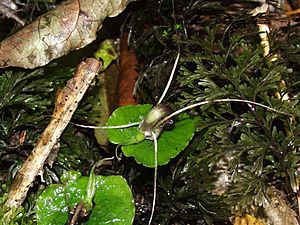Dancing spider orchid facts for kids
Quick facts for kids Dancing spider orchid |
|
|---|---|
 |
|
| Corybas acuminatus on Mt. Maungatautari | |
| Scientific classification | |
| Synonyms | |
|
The dancing spider orchid (also called the helmet flower) is a special type of orchid. Its scientific name is Corybas acuminatus. This orchid only grows in New Zealand. It has a leaf shaped like a triangle with a sharp tip. Its small flower is greenish-white and see-through, with purple marks. It also has very long parts called sepals. You can find it on New Zealand's main islands and some smaller islands too.
What Does It Look Like?
The dancing spider orchid is a plant that grows on the ground. It lives for many years. It loses its leaves each year. It has one leaf that is shaped like a triangle or a heart. This leaf can be up to 40 millimeters (about 1.5 inches) long. It can be up to 20 millimeters (about 0.8 inches) wide. The tip of the leaf is very sharp. The top of the leaf is light green. The bottom is silvery with red lines.
The Flower
A single flower grows right above the leaf. It is mostly see-through. It has dull red stripes. The biggest part of the flower is called the dorsal sepal. It can be up to 40 millimeters long. It has a long, thin, thread-like tip that sticks out. The other two sepals are called lateral sepals. They stand up straight and are also thread-like. These can be up to 60 millimeters (about 2.4 inches) longer than the rest of the flower.
The petals are like the lateral sepals but smaller. They either stick out sideways or point downwards. The labellum is a special part of the flower. It is red and creamy green. It has two round, ear-like shapes near its base. This orchid flowers from August to December.
How It Got Its Name
The dancing spider orchid was first officially described in 1991. Two scientists, Mark Clements and Edwin Hatch, described it. They found a sample near a place called Karekare. Their description was published in the New Zealand Journal of Botany.
The second part of its scientific name, acuminatus, is a Latin word. It means "pointed" or "sharpened." This name was chosen because of the sharp, pointed shape of the orchid's leaf.
In 2002, some scientists suggested changing the orchid's scientific group. They wanted to move it from Corybas to a new group called Nematoceras. However, this change has not been widely accepted by other scientists.
Where It Lives
The dancing spider orchid likes to grow in damp, shady forests. You can find it on New Zealand's main islands: the North Island, South Island, and Stewart Island. It also grows on some smaller islands like Chatham Island and Auckland Islands.
Is It Safe?
The New Zealand Government Department of Conservation says that Corybas acuminatus is "not threatened." This means it is not in danger of disappearing.

